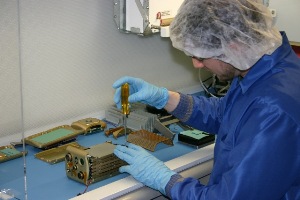Sep 8 2014
Marking another first in the storied history of the company, Vision Research, a leading manufacturer of digital high speed imaging systems, proudly announces that its high-performance Phantom® v7.3 digital camera is now orbiting the Earth at a distance of over 200 miles on board the International Space Station (ISS).
The Phantom v7.3 arrived on August 12th as part of the payload delivered by the Georges Lemaître ATV (Automated Transfer Vehicle 5 / ATV-5) on what was the final flight of the European ATV unmanned cargo resupply spacecraft program.
 Assembly of the Phantom v7.3 that is now incorporated into a specially designed electromagnetic levitator (EML), a state-of-the-art joint project built by Airbus Defense and Space under contracts from the European Space Agency (ESA) and German Aerospace Center (Deutsches Zentrum fur Luft- und Raumfahrt; DLR).
Assembly of the Phantom v7.3 that is now incorporated into a specially designed electromagnetic levitator (EML), a state-of-the-art joint project built by Airbus Defense and Space under contracts from the European Space Agency (ESA) and German Aerospace Center (Deutsches Zentrum fur Luft- und Raumfahrt; DLR).
The Phantom v7.3 is incorporated into a specially designed electromagnetic levitator (EML), a state-of-the-art joint project built by Airbus Defense and Space under contracts from the European Space Agency (ESA) and German Aerospace Center (Deutsches Zentrum für Luft- und Raumfahrt; DLR). The camera will provide high-speed image capture for groundbreaking zero-gravity experiments and support research in the field of meta-stable states and phases and in the field of measurement of high-accuracy thermophysical properties of liquid metallic alloys at high temperatures. Specifically, the Phantom high-speed video will be used to analyze the undercooling and solidification speeds by measurement of undercooling temperature and solidification velocity. German ESA astronaut Alexander Gerst will perform the experiments using the EML in the European Columbus Laboratory aboard the ISS.
"To have one of our cameras stationed on the ISS and to have taken the journey on board the historic flight of ATV-5 is truly an honor and defining moment for Vision Research," said Rick Robinson, Director of Marketing for Vision Research.
"Our engineers worked diligently to meet the project's specific needs. The adaptability of the v7.3 to work seamlessly with the EML speaks to the robust capabilities of the technology found in each of our Phantom cameras. We're confident that over the next several years the camera will help further advance the zero-gravity research, and we are excited to learn the results of the experiments."
Before it could be incorporated into the EML, the Phantom v7.3 went through a comprehensive overhaul, with modifications made inside and out, to ensure safety and meet the strict requirements of the ESA and DLR. As with any electronics based equipment sent into space, the Phantom v7.3 was put through a series of rigorous tests for EMI interference as well as vibration and stress, ensuring that the camera would survive the volatile launch into orbit. The camera also was designed without the use of components that contain such materials as cadmium or lithium and manufactured using a paintless enclosure.
The Phantom v7.3
The Vision Research Phantom v7.3 features a high-performance, custom designed 800x600 CMOS sensor, which offers the ultimate in image quality and light sensitivity. Highly versatile, the Phantom v7.3 boasts two operating modes. In standard mode, the camera can capture images between 6,700 fps and 190,000 fps, depending upon resolution, and can adjust exposure programmable up to 1/frame-rate. In turbo mode, the Phantom v7.3 can acquire images up to 500,000 fps at a resolution of 32x16 and with a fixed 1 microsecond exposure time.
To find out the latest on Vision Research and its high-speed cameras, follow on Twitter at @PhantomHiSpeed, LinkedIn at Vision Research, Facebook at "visionresearch" or keep up to date with the innovations on the Vision Research blog at www.visionresearch.com/blog.
About Vision Research
Vision Research is a leading manufacturer of high-speed digital imaging systems that are indispensable across a wide variety of applications, including defense, automotive, engineering, science, medical research, industrial manufacturing, packaging, sports broadcast, TV production and digital cinematography.
The Wayne, N.J.-based company designs and manufactures the most comprehensive range of digital high-speed cameras available today, all of which deliver unsurpassed light-sensitivity, image resolution, acquisition speed and image quality.
Over the course of its 60+ year history, Vision Research has earned numerous awards in recognition of its innovations in high-speed digital camera technology and sensor design, including a technical Emmy and an Academy Award®.
Vision Research digital high-speed cameras add a new dimension to the sense of sight, allowing the user to see details of an event when it's too fast to see, and too important not to™. For additional information regarding Vision Research, please visit www.visionresearch.com.
Vision Research is a business unit of the Materials Analysis Division of AMETEK Inc., a leading global manufacturer of electronic instruments and electromechanical devices.